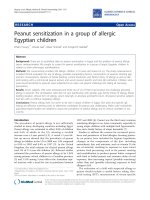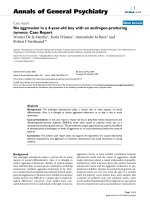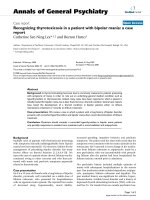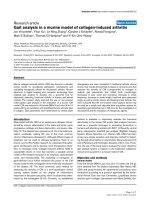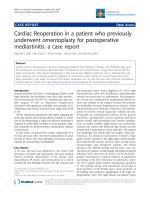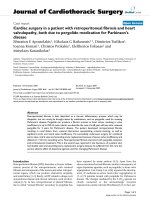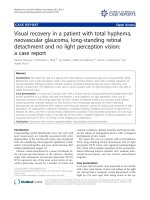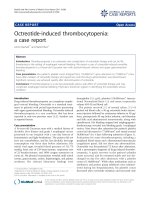Báo cáo y học: "Cervical stenosis in a professional rugby league football player: a case report" pdf
Bạn đang xem bản rút gọn của tài liệu. Xem và tải ngay bản đầy đủ của tài liệu tại đây (245.2 KB, 6 trang )
BioMed Central
Page 1 of 6
(page number not for citation purposes)
Chiropractic & Osteopathy
Open Access
Case report
Cervical stenosis in a professional rugby league football player: a
case report
Henry Pollard*
1
, Lotte Hansen
2
and Wayne Hoskins
3
Address:
1
Department of Health and Chiropractic, Macquarie Injury Management Group, Macquarie University, 2109, Sydney Australia,
2
Lotte
Hansen Chiropractic, 70 Donald Street, Hamilton NSW 2303 Australia and
3
Department of Health and Chiropractic, Macquarie Injury
Management Group, Macquarie University, 2109, Sydney Australia
Email: Henry Pollard* - ; Lotte Hansen - ;
Wayne Hoskins -
* Corresponding author
manipulation, chiropracticnon operative treatmentcervical, radiculopathysport, injuryrugby league
Abstract
Background: This paper describes a case of C7 radiculopathy in a professional rugby league player
after repeated cervical spine trauma. The report outlines the management of the patient following
an acute cervical hyperflexion injury with chiropractic manipulation and soft tissue therapies. It also
presents a change in approach to include distractive techniques on presentation of a neurological
deficit following re-injury. The clinical outcomes, while good, were very dependent upon the
athlete restricting himself from further trauma during games, which is a challenge for a professional
athlete.
Case presentation: A 30-year old male front row Australian rugby league player presented
complaining of neck pain after a hyperflexion and compressive injury during a game. Repeated
trauma over a four month period resulted in radicular pain. Radiographs revealed decreased disc
height at the C5-C6 and C6-C7 levels and mild calcification within the anterior longitudinal ligament
at the C6-C7 level. MRI revealed a right postero-lateral disc protrusion at the C6-C7 level causing
a C7 nerve root compression.
Conclusion: Recommendations from the available literature at the present time suggest that
conservative management of cervical discogenic pain and disc protrusion, including chiropractic
manipulation and ancillary therapies, can be successful in the absence of progressive neurological
deficit. The current case highlights the initial successful management of a football athlete, and the
later unsuccessful management. This case highlights the issues involvement in the management of a
collision sport athlete with a serious neck injury.
Background
Effective cervical injury management requires an under-
standing of the pathomechanics of injury [1]. There are
numerous reports in the literature on cervical injuries in
full contact collision sports such as rugby (United King-
dom), rugby league/union (Australia) and American foot-
ball (United States) [2-7]. However, there is a lack of
literature on treatment, particularly non-operative
Published: 03 August 2005
Chiropractic & Osteopathy 2005, 13:15 doi:10.1186/1746-1340-13-15
Received: 11 April 2005
Accepted: 03 August 2005
This article is available from: />© 2005 Pollard et al; licensee BioMed Central Ltd.
This is an Open Access article distributed under the terms of the Creative Commons Attribution License ( />),
which permits unrestricted use, distribution, and reproduction in any medium, provided the original work is properly cited.
Chiropractic & Osteopathy 2005, 13:15 />Page 2 of 6
(page number not for citation purposes)
manual therapy. This case report proposes an approach to
address discogenic pain and disc protrusion. Injury man-
agement of a professional athlete is a challenge given the
pressure on the player to play each match and perform
through the competitive season.
Case Presentation
Case Report
A 30 year old professional Australian rugby league player
presented complaining of diffuse neck pain following a
hyperflexion and compressive neck injury while being
tackled with his neck in maximal flexion. The injury
occurred six days prior to presentation. There had been no
significant previous history of injury or concussions over
a 15 year career.
On examination, pain was reproduced in the right trape-
zius area on forward flexion and neurological testing was
normal. There was no upper limb pain present. Other test-
ing, including vertebral artery and blood pressure testing,
proved unremarkable. Treatment consisted of high veloc-
ity, low amplitude manipulative therapy directed to the
C2, C5 and T1 levels and proprioceptive neuromuscular
facilitation (PNF) stretching to the trapezius and cervical
musculature. This resulted in full pain free cervical ROM
in three treatments.
Over the next four months the patient presented on five
more occasions for similar cervical injuries following
hyperflexion and compressive injuries while being tackled
in matches. Symptoms progressed to include frontal head-
aches and cervico-thoracic pain. Treatment continued to
include manipulation to the cervical and thoracic spine,
PNF, soft tissue massage and trigger point therapy to the
trapezius, sterno-cleido mastoid (SCM) and suboccipital
musculature. This resulted in symptomatic relief within
two to three treatments at each presentation. Over the
four month period blood pressure and upper limb neuro-
logical status was monitored which proved to be
unremarkable.
Four months after the initial presentation, the patient pre-
sented again following a combined hyperflexion with left
lateral rotation injury after a collision in a game. Severe
pain was immediately experienced over the right lower
neck with pain radiating into the right upper trapezius
region. Cervical radiographic images were ordered,
including lateral, anterio-posterior, antero-posterior open
mouth, oblique and functional views in flexion and exten-
sion. These views revealed decreased disc height at the C5-
C6 and C6-C7 levels with mild osteophytic lipping. No
definite instability was demonstrated. On the oblique
view the intervertebral foramina appeared normal
throughout the cervical spine.
A working diagnosis of an acute C6 disc lesion was estab-
lished and the patient was advised to consult the team
physician for advanced imaging to determine the state of
any disc disruption. He continued to receive two treat-
ments per week to manage his symptoms. Treatment was
directed toward the management of the acute symptoms
with ice, soft tissue therapy and manipulation to sites
around (but not on) the lesion. The patient was also
advised to commence a short course of non-steroidal anti-
inflammatory medication (NSAIDs). Practitioners should
be mindful of their recommendations as all medications
must be deemed appropriate according to the governing
sport's policy on sports doping.
After each game for a two month period symptoms pro-
gressively worsened until he presented with severe con-
stant pain in the right upper trapezius region. This time
the right triceps muscle strength was significantly reduced
and the pain was relieved by elevating the right arm over
his head and by cervical traction, indicating possible neu-
ral impingement. Other upper limb neurological testing,
including upper limb deep tendon reflexes and sensory
testing, was negative.
The clinical diagnosis was altered to a C6 radiculopathy.
Treatment was altered to intermittent cervical traction and
pulsed ultrasound therapy to the right trapezius area twice
per week. Home advice included the use of an ice pack (20
minutes on the hour) and intermittent cervical traction
three times a day. NSAID use was advised.
Two weeks later the patient presented with cervico-tho-
racic pain after being hit on the left side of his head while
being tackled. Cervical ROM was full but painful in right
rotation, flexion and extension. Upper limb neurological
testing was unremarkable. A non-specific soft tissue
sprain/strain diagnosis was given. Treatment involving
cervical and thoracic manipulation and massage was
again delivered with symptomatic relief. He was advised
not to play rugby league until his symptoms had settled.
The patient continued to play and one month later began
experiencing numbness in the second and third digits of
his right hand. The Door Bell Sign over the right lower cer-
vical area (pressure over the IVF at the antero-lateral aspect
of the neck) reproduced the radicular symptoms. Other
upper limb neurological testing was normal. The patient
continued to receive intermittent cervical traction, gentle
mobilisation of the cervical spine and manipulation to
the upper thoracic area, along with massage therapy twice
per week.
Four days later team medical staff referred the patient for
magnetic resonance imaging (MRI). The MRI revealed a
right postero-lateral disc protrusion at the C6-C7 level.
Chiropractic & Osteopathy 2005, 13:15 />Page 3 of 6
(page number not for citation purposes)
The patient was strenuously advised not to play for three
weeks, or to do upper body weight training. Two weeks
later after following this advice the patient had regained
full cervical ROM and pain was only reproduced on pas-
sive flexion and extension. He was still experiencing
numbness in the second and third digits of the right hand.
He began playing games again before finishing the season
three weeks later.
Follow up two months post season showed no pain or
restriction to cervical ROM. He was still experiencing
some numbness in the second digit of the right hand, and
the right triceps muscle was slightly weak. Whilst a new
symptom, the mild nature of the tricep weakness was not
considered serious, but it was to be monitored closely for
any signs of deterioration. The player was informed of this
approach and consented to it. Other neurological and
orthopaedic tests were negative (shoulder and elbow
range of motion, and Phalen's test). The athlete was
advised to gradually build up his weight training and to
maintain cervical flexibility with strengthening and
stretching exercises.
The player was still reluctant to stop football and has since
been advised by his orthopaedic surgeon to have discec-
tomy surgery and to fuse the C6-C7 level, requiring six
months of rehabilitation before returning to play. The
player did not have the surgery and rested until the fol-
lowing year where he began the process all over again. He
is now retired from football.
Literature Review
This case outlines a series of cervical traumas producing
neck, arm and head pain. The series of injuries involved
forced flexion, compression and lateral deviation away
from the painful side. This mechanism is in contrast to the
mechanism of extension with lateral deviation towards
the painful side as described in the majority of studies of
neck injuries in American football and rugby [2,5,6], The
clinical signs suggest a disc herniation following repeated
trauma resulting in compression of the C7 nerve root.
There are several studies reporting chronic recurrent cervi-
cal nerve root neuropraxia (sometimes called "chronic
burner syndrome"), in American football [5,6] and in
rugby players [2]. This can commonly occur during block-
ing, tackling or engaging in a scrum. Chronic burner syn-
drome can be defined as:
1) a chronic recurrent neuropraxia or axonotmesis, or
both, of a nerve root associated with prolonged weakness,
2) time loss from practice and games, and
3) recurrence [6].
Nerve root compression in the intervertebral foramina
secondary to disc herniation or degenerative changes, or
both, is the most common cause in football players seen
with recurrent or chronic burners [6]. In such cases,
degenerative changes frequently present with concurrent
cervical canal stenosis and can predispose injury [8].
A correlation seems to exist between chronic recurrent cer-
vical nerve root neurapraxia and cervical canal stenosis in
tackled football players [1,5-7] and risk of more serious
cervical spine injury increases with increasing stenosis [9].
A spinal canal-vertebral body ratio (Pavlov's ratio) on lat-
eral radiographs of 0.80 or less (normal ratio 1:1) at one
or more levels has been found in a tackle football popula-
tion who have experienced an episode of cervical cord
neuropraxia manifested by sensory and/or motor symp-
toms [10]. Despite a series of minor neurological insults,
no correlation between the prodromal episodes of cord
neuropraxia and occurrence of permanent quadriplegia
has been found [10]. Also, the presence of uncomplicated
developmental narrowing of the stable cervical spine does
not predispose permanent neurological injury [1].
Absolute contraindications to continued participation in
contact sports has been recommended to apply to those
individuals who have had a documented episode of cervi-
cal cord neurapraxia associated with the following:
• ligamentous instability,
• intervertebral disc disease with cord compression,
• significant degenerative changes,
• MRI evidence of cord defects or swelling,
• positive neurological findings lasting more than 36
hours,
• more than one recurrence [10].
The extremely low predictive value of Pavlov's ratio (as an
indicator of clinically relevant spinal stenosis) precludes
its use as a screening mechanism for determining partici-
pation in contact activities [7]. To accurately assess spinal
canal stenosis, cross-sectional imaging technology such as
MRI, contrast positive CT, and myelography should be
employed [7]. Plain radiographic identification of a nar-
row spinal canal in a player sustaining cervical cord neu-
ropraxia warrants MRI investigation to rule out soft tissue
based stenosis [11].
Mechanism of Injury
Most of the literature on cervical spine injuries in football,
such as burner syndrome, emphasises an extension type
Chiropractic & Osteopathy 2005, 13:15 />Page 4 of 6
(page number not for citation purposes)
mechanism of injury. In our case, the mechanism of
injury involved both hyperflexion and a compressive
force. As hyperflexion involves more compressive load to
the cervical spine than extension, this combination has a
greater potential for injury, particularly if a stenosis situa-
tion concurrently exists [12].
With cervical hyperflexion, the spinolaminar line of the
superior vertebra and the posterior superior aspect of the
vertebral body below approximate, resulting in a rapid
decrease of the spinal canal with compression of the spi-
nal cord [1]. The brief, sudden deformation of the cord is
thought to produce disturbed sensory and motor function
below the involved level [1,13]. In most instances of acute
spinal injury, disruption of cord function is the result of
local cord anoxia and increased concentration of intracel-
lular calcium [1]. Playing with improper technique, such
as spear tackling, has been associated with catastrophic
injuries [14]. In the case presented in this report, the tech-
nique of running at a tackler with neck hyperflexion
before impact contributed to the repetitive history of
injury and should have been corrected.
Hyperflexion injuries in Whiplash-Associated-Disorders
(WAD) do not involve the exact same mechanism of
injury (i.e. absence of axial compression) but the soft tis-
sue damage can be very similar [15]. For example, Grade
III WAD features include: cervical herniated disc, cervical-
gia with headaches and limited range of motion com-
bined with neurologic symptoms and signs are present
[15].
With compression, a force exerted through the crown of
the head can be transmitted through the skull to the cervi-
cal vertebrae resulting in the crushing of the vertebrae and
extrusion of the vertebral body and disc material posteri-
orly into the cervical vertebral canal [3]. When the cervical
spine is in hyperflexion with rotation, vertebral disloca-
tion without fracture is possible, which is more likely if
the head is locked on the ground adding a compressive
force [15]. The most damaging mechanisms of injury to
the spine are torsional and combined motions (i.e. for-
ward flexion and lateral rotation) with a combined axial
load [17,18].
Management
Most of the literature involving treatment of patients with
cervical disc herniations producing neurologic loss
reports surgical outcomes. Furthermore, reports of
patients with cervical spondylotic myelopathy show the
symptoms progress gradually or step-wise and recovery of
neurological function after conservative treatment or
decompression surgery is common [19-21]. There is a lack
of literature on manual therapy for an acute presentation
of chronic recurrent cervical nerve root neuropraxia.
The treatment protocol in the acute phase should involve
rest, ice and intermittent traction [22]. Case reports have
shown successful chiropractic management of radicular
and pseudoradicular pain through high-velocity, low
amplitude thrust techniques and associated soft tissue
therapies [23]. Manipulative therapy to the spinal seg-
ments above and below the painful levels, after the appro-
priate pre-manipulative provocation testing for
verebrobasilar insufficiency has been performed, is
believed to aid in increasing fluid infusion, and decreas-
ing nociceptive input to the spinal cord [24]. The chiro-
practic literature suggests, in cases of cervical disc
herniation, that manipulative therapy of the involved
level is delivered only in the sub-acute phase, with the line
of thrust being only in the pain-free directions [22].
The practitioner should be mindful of the potential for
iatrogenic joint instability to occur. Damage to the sup-
porting structures resulting in hypermobile joints can be
aggravated by and result from repeated manipulations
[25]. The recommended management protocol for Grade
III WAD, which is a similar injury, is shown in Table 1 and
could be viewed as a guideline for management of foot-
ballers with cervical stenosis [15].
The role of surgical versus non-surgical treatment of
patients with cervical disc herniation has been compared
in a longitudinal cohort study [26]. Twenty-six subjects
with a clearly defined diagnosis of cervical herniated
nucleus pulposus on MRI were evaluated for outcome
with conservative treatment. This included ice, rest, hard
cervical collar, NSAIDs for six to 12 weeks, manual and
mechanical traction followed by home traction, and pro-
gressive strengthening exercises of the shoulder girdle and
chest with training in postural control and body mechan-
ics training. Follow up for over a year showed that 24 of
the patients were successfully treated without surgery.
Table 1: Management of Grade III Whiplash Associated
Disorders (WAD) [15]
• Soft collars should not be used as they do not adequately immobilise
the spine
• Narcotic analgesics may occasionally be needed for pain relief.
Psychopharmacologic drugs and muscle relaxants should not be used
• In the few cases in which rest for the neck might be indicated, it
should be limited to less than four days and followed by early
activation
• The Task Force consensus is that manipulative treatments by trained
persons for the relief of pain and facilitating early mobility can be used
in WAD
• Long term repeated manipulation or physiotherapy without
multidisciplinary evaluation is not justified
• Surgery for WAD patients is rarely indicated. Surgery is only
indicated for Grade III patients with progressive neurologic deficit or
persisting arm pain
Chiropractic & Osteopathy 2005, 13:15 />Page 5 of 6
(page number not for citation purposes)
Twenty patients achieved good or excellent results deter-
mined by symptom level, activity and function level, med-
ication and ongoing medical care, job status and
satisfaction. Only two patients required surgery suggesting
that many cervical disc herniations can be successfully
managed with conservative treatment.
Low level evidence from the available literature suggests
that conservative management of discogenic pain and disc
protrusion can be as successful as surgical treatment.
However, such approaches, including corticosteroid injec-
tions [28], need to be validated by higher level evidence
such as a randomised controlled trial [26,27]. Further, the
current clinical trials have not included an athletic
population.
It has been suggested that individuals with disc hernia-
tions will require lifelong management to ensure long-
term participation in sport [26,27]. However, at present
there is little evidence to support or refute such an
approach. Based on a study of American football players
the current recommendations for an athlete with interver-
tebral disc injury participating in a contact sport is as
follows:
1. No contraindication to participate in contact sport in
individuals with a healed disc herniation treated
conservatively,
2. Relative contraindication in individuals with facet
instability,
3. Absolute contraindication in individuals with:
a. Acute disc herniation (with or without neurological
findings)
b. Acute or chronic disc herniation with decreased cervical
range of motion,
c. Acute or chronic disc herniation with signs and symp-
toms of cord neuropraxia due to congenital stenosis of the
cervical canal [4].
According to these recommendations the patient
described in this case report would belong in group 3a)
and should therefore not have played until his symptoms
had subsided. With professional athletes a player can be
reluctant to report injuries for fear of losing a spot in the
team or losing wages. Despite not believing it is safe to
play with injuries, many athletes are willing to risk doing
so [29]. The authors of this study further concluded that:
individuals with uncomplicated cervical cord neuropraxia
can return to play without risking further damage, and
various clinical manifestations are not related to the radi-
ological findings.
The current literature agrees that the fundamental require-
ments for return to contact sports to include: normal
strength, painless range of motion, a stable vertebral col-
umn and adequate space for the neurological elements
[14]. Return to play guidelines need to be further investi-
gated as several approaches exist and are open to interpre-
tation. Some approaches allow a more liberal return to
play criteria and would more likely be used with profes-
sional sports persons. Other return to play criteria are less
liberal and would be used for amateurs and junior players
A one level surgical fusion has been suggested not to
present any contraindication to participation in contact
activities provided the athlete is completely asymptomatic
and neurologically normal when commencing sport [4].
In a prospective study it was found that most cervical disc
herniations regress with time and without the need for
surgical resection [30]. Patients were finally examined and
discharged from care because of sustained pain control at
an average of six months. These findings are similar to
four cases reporting spontaneous resolution of cervical
herniation [31]. Given that surgery will require six
months of rest from contact sport and a rehabilitation
program, one may question whether the same outcomes
with aggressive conservative therapy would have similar if
not better results. Guidelines for surgical cases need to be
clearly defined and randomised controlled trials compar-
ing surgical to conservative care performed.
A review of the management of lumbar intervertebral disc
injuries in athletes suggests that the high recurrence rate of
low back pain may indicate that the resolution of symp-
toms is accompanied by restoration of function [27]. This
is possibly due to functional changes that occur with
injury, which can be assumed to occur with cervical disc
injuries. Cervical dysfunction can be caused by failure to
rehabilitate previous injuries [32,33], a scenario com-
monly encountered in the professional athlete who fre-
quently returns to play sooner than the ideal. This
becomes important for an athlete as performance can suf-
fer in the absence of pain but in the presence of subtle bio-
mechanical maladaptations [27].
Conclusion
This case report has outlined the progression of cervical
injury to a disc protrusion resulting in a C7 radiculopathy
in a professional rugby league player, due to numerous
blows to the cervical spine after a series of hyperflexion
injuries. The patient ultimately suffered a severe forced
flexion combined with left lateral flexion injury to the cer-
vical spine and experienced sensory and motor changes in
the right C7 nerve root distribution. When it became
Publish with BioMed Central and every
scientist can read your work free of charge
"BioMed Central will be the most significant development for
disseminating the results of biomedical research in our lifetime."
Sir Paul Nurse, Cancer Research UK
Your research papers will be:
available free of charge to the entire biomedical community
peer reviewed and published immediately upon acceptance
cited in PubMed and archived on PubMed Central
yours — you keep the copyright
Submit your manuscript here:
/>BioMedcentral
Chiropractic & Osteopathy 2005, 13:15 />Page 6 of 6
(page number not for citation purposes)
apparent that there was intervertebral foramen encroach-
ment secondary to a disc protrusion the treatment proto-
col changed toward a more conservative approach.
It is important that the athlete is informed of the problem
with particular regard to potential risks if they continue to
play. When considering surgery, the long-term conse-
quences of the intervention should be thoroughly dis-
cussed with the athlete along with all potential
management options including no treatment and retire-
ment from the sport. Further research is needed on the
chiropractic management of acute athletic injuries to the
spine and the long-term outcome for surgery versus con-
servative management of patients wishing to continue
their athletic career.
Authors' contributions
HP conceived of the study, participated in its design and
helped to draft and edit the manuscript.
LH provided treatment to the subject and helped draft the
manuscript
WH helped to collect literature and draft the manuscript.
All authors read and approved the manuscript.
References
1. Torg JS, Thibault L, Sennett B, Pavlov H: The pathomechanics and
pathophysiology of cervical spinal cord injury. Cl Orth Rel Res
1995, 321:259-269.
2. Wetzler MJ, Akpata T, Albert T, Foster TE, Levy AS: A retrospec-
tive study of cervical spine injuries in American rugby, 1970
to 1994. Am J Sports Med 1996, 24(4):454-458.
3. Silver JR, Stewart D: The prevention of spinal injuries in rugby
football. Paraplegia 1994, 32(7):442-453.
4. Torg JS, Ramsey-Emrhein JA: Suggested management guidelines
for participation in collision activities with congenital, devel-
opmental, or postinjury lesions involving the cervical spine.
Med Sci Sports Exerc 1997, 29(7):S256-S272.
5. Markey KL, Denedetto MD, Curl WW: Upper trunk brachial
plexopathy. Am J Sports Med 1993, 21(5):650-655.
6. Levitz CL, Reilly PJ, Torg JS: The pathomechanics of chronic,
recurrent cervical nerve root neurapraxia. Am J Sports Med
1997, 25(1):73-76.
7. Cantu RC: Stingers, transient quadriplegia, and cervical spinal
stenosis: Return to play criteria. Med Sci Sports Exerc 1997,
29(7):S233-S235.
8. Weinberg J, Rokito S, Silber JS: Etiology, treatment, and preven-
tion of athletic "stingers". Clin Sports Med 2003, 22(3):493-500.
9. Castro FP Jr: Stingers, cervical cord neurapraxia, and stenosis.
Clin Sports Med 2003, 22(3):483-92.
10. Torg JS: Cervical spinal stenosis with cord neurapraxia and
transient quadriplegia. Sports Med 1995, 20(6):429-434.
11. Kim DH, Vaccaro AR, Berta SC: Acute sports-related spinal cord
injury: contemporary management principles. Clin Sports Med
2003, 22(3):501-12.
12. Bhatoe HS: Cervical spinal cord injury without radiological
abnormality in adults. Neurol India 2000, 48(3):243-8.
13. Breslow MJ, Rosen JE: Cervical spine injuries in football. Bull
Hosp Jt Dis 2000, 59(4):201-10.
14. Morganti C: Recommendations for return to sports following
cervical spine injuries. Sports Med 2003, 33(8):563-73.
15. Spitzer WO, Skovron ML, Salmi LR, Cassidy JD, Duranceau J, Suissa
S, Zeiss E: Scientific monograph of the Quebec Task Force on
Whiplash Associated Disorders: Redefining "Whiplash" and
its management. Spine 1995:21S-38S.
16. Bauze RJ, Ardran GM: Experimental production of forward dis-
location in the human cervical spine. J Bone Joint Surg Br 1978,
60:239-245.
17. Quarrie KL, Cantu RC, Chalmers DJ: Rugby union injuries to the
cervical spine and spinal cord. Sports Med 2002, 32(10):633-53.
18. Torg JS, Guille JT, Jaffe S: Injuries to the cervical spine in Amer-
ican football players. J Bone Joint Surg Am 2002, 84(1):112-122.
19. Ito T, Oyanagi K, Takahashi H, Takahashi HE, Ikuta F: Cervical
spondylotic myelopathy. Spine 1996, 21(7):827-833.
20. Geck MJ, Eismont FJ: Surgical options for the treatment of cer-
vical spondylotic myelopathy. Orth Cl Nth Am 2002,
33(2):329-48.
21. Emery SE: Cervical spondylotic myelopathy: diagnosis and
treatment. J Am Acad Ortho Surg 2001, 9(6):376-88.
22. Hubka MJ, Phelan SP, Delaney PM, Robertson VL: Rotary manipu-
lation for cervical radiculopathy: observations on the impor-
tance of the direction of the thrust. J Manipulative Physiol Ther
1997, 20(9):622-7.
23. Pollard H, Tuchin P: Cervical radiculopathy: A case for ancillary
therapies? J Manipulative Physiol Ther 1995, 18(4):244-249.
24. Patterson MM: The spinal cord: Participant in disorder. Spinal
Manipulation 1993, 9(3):2-11.
25. Hurwitz EL, Aker PD, Adams AH, Meeker WC, Shekelle PG: Manip-
ulation and mobilisation of the cervical spine: A systematic
review of the literature. Spine 1996, 21(15):1746-1758.
26. Saal JS, Saal JA, Yurth EF: Nonoperative management of herni-
ated cervical intervertebral disc with radiculopathy. Spine
1996, 21(16):1877-1883.
27. Young JL, Press JM, Herring SA: The disc at risk in athletes: Per-
spectives on operative and nonoperative care. Med Sci Sports
Exerc 1997, 29(7):S222-S232.
28. Slipman CW, Chow DW: Therapeutic spinal corticosteroid
injections for the management of radiculopathies. Phys Med
Rehabil Clin N Am 2002, 13(3):697-711.
29. Finch C, Donohue S, Garnham A: Safety attitudes and beliefs of
junior Australian football players. Inj Prev 2002, 8(2):151-4.
30. Bush K, Chaudhuri R, Hillier S, Penny J: The pathomorphologic
changes that accompany the resolution of cervical
radiculopathy. Spine 1997, 22(2):183-187.
31. Vinas FC, Wilner H, Rengachary S: The spontaneous resorption
of herniated cervical discs. J Clin Neurosci 2001, 8(6):542-6.
32. Herring SA, Weinstein SM: Assessment and nonsurgical man-
agement of athletic low back injury. In The Lower Extremity &
Spine in Sports Medicine 2nd edition. Edited by: Nicholas JA, Hershman
EB. St. Louis: Mosby-Year Book; 1995:1171-1197.
33. Kibler WB: Clinical aspects of muscle injury. Med Sci Sports Exerc
1990, 22(4):450.
